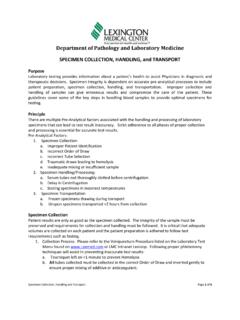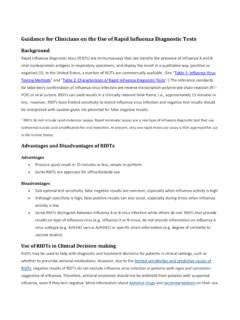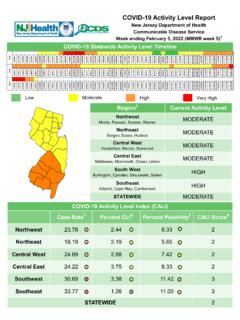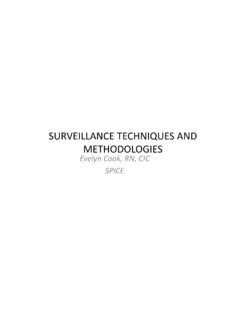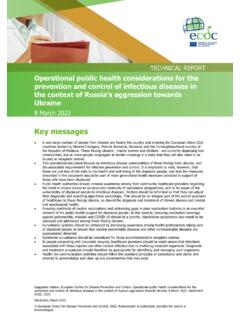Transcription of Laboratory-General Specimen Collection and Handling …
1 Laboratory-General Specimen Collection and Handling Guidelines Page 1 of 49 Contents: Microbiology continued. Orders/Requests Stool Patient Preparation Throat or Pharynx Specimen Containers Tuberculosis (TB) Specimen Quality Urine Order of Draw Viral Specimen Transport VRE Surveillance (Vancomycin- Resistant entercoccus) Specimen Rejection Wound general Lab Sample/Source: Whole Blood Cytology (Cytopathology) Plasma Aspiration, Fine Needle Serum Aspiration, Cyst Fluids Urine Submission of slide Fecal (Stool) Tips on making smears Body Fluid Body Cavity Fluids Cerebrospinal Spinal Fluid Breast Nipple Secretions Synovial Fluid Brushing Specimens Microbiology Cerebrospinal Fluid (CSF) Sample/Source.
2 Ectocervix, Endocervical canal, Vaginal pool Abscess (Deep aspirate) Pap Smear, Conventional Abscess (superficial swab) Pap Smear, Liquid Base Acid Fast Bacillus (AFB) Sputum Specimens Anaerobic Surface Scrape Specimen (Tzanck Smear) Aspirate, drainage, cyst fluid, or pustule Vaginal Wall (Maturation Index) Biopsy, Bone, Tissue Washing Specimens Blood (Adult) Histology (Anatomic Pathology) Blood )Pediatric Routine Submission Blood for Acid Fast Bacillus (AFB) Fresh Specimen Body Fluids Surgical Specimen and Microbiology test(s) Bronchial Washing Lavage Breast Tissue Catheter Tip Brushing Specimens C.
3 Difficile Toxin B Bronchial Washing and Brushings Chlamydia/Gonorrhea Amplified Detection Muscle Biopsy Crytococcal Antigen Renal Biopsy (Kidney) Cerebral Spinal Fluid (CSF) Renal calculi (Kidney/Bladder Stones) Ear (outer) Bone Marrow Ear (inner) Cytogenics Eye (Conjunctive) Flow Cytometry Foreign Bodies Frozen Section Fungus (Mycology) (fluid or material) Permanents, Blocks, Slides Fungus (Mycology) (skin, hair, or nails) Gross Only Examination Foreign bodies/Hardware Genital Tract (female) Crystal Studies Group A Strep Blood Bank (Immunohematology)
4 Group B Strep ABO Group & Rh Type Helicobacter Pylori Antibody Detection, RBC influenza Antigen Antibody Titer Lactoferrin Direct Coombs Legionella Elution & Antibody MRSA Surveillance RhoGam Mycoloplasma/Ureaplasma RH Type Only Nasal Type & Screen Ova and Parasite Type and Crossmatch Bordetella Pertussis (Whooping Cough) Transfusion Products Pinworm Transfusion Reaction Rotovirus Crossmatch Sexual Transmitted Infections (STI) Delivery and transport Sputum Returning Unused Blood Cord Blood Specimens Pre-Admission Testing Emergency Issue of Blood Products Laboratory-General Specimen Collection and Handling Guidelines Page 2 of 49 Orders/Requests: Requisition must include.
5 O Patient's full legal name, o Date of birth (DOB), o Attending/Ordering physician, o Date and time of Collection , o Specific test(s) requested ( , Do Not request CMV Antibody clarify IgG or IgM Antibody) o Specimen site and source when indicated, o Clinical symptoms or diagnosis (ICD-9) Instruct patient to bring insurance information and photo identification when visiting a Patient Service Center to expedite their visit. If specimens will be collected in the office, attach a copy of patient demographics and insurance information to the requisition. Patient Preparation: Many tests require that the patient be prepared in some specific way to ensure useful results. Highest quality results begin with the quality of the Specimen that has been submitted for analysis.
6 We want to provide you with the most useful information possible. If you have questions about patient preparation for any test, refer to our Test Directory or contact Client Services at 440-329-7863 for further assistance. Fasting requirements: o For the majority of test(s) performed on serum, plasma or whole blood, a fasting Specimen is preferred. Fat particles contained in Non-fasting specimens often interfere with many analytical procedures. Fasting is defined as no consumption of food or beverage, other than water, for eight (8) to twelve (12) hours. Provocation tests: o Some tests require the patient to ingest a substance. The most common are the Glucose Tolerance Tests where the patient drinks a solution containing glucose, and blood specimens are obtained before and at various times after the drink to measure the concentration of glucose in plasma or serum.
7 Specimen Containers: Label container with: o Patient's full legal name, o Patient DOB, o Date and time of Collection , o Initials of the person collecting the sample (for Blood bank specimens), o Specimen source and specific site as appropriate for non-blood specimens (Microbiology, Histology, etc.) Label the container not the lid or biohazard bag When submitting glass slides, label the frosted end using a pencil with Patient's full name and DOB If smears are prepared from different areas label each slide appropriately. Specimen Containers: Laboratory-General Specimen Collection and Handling Guidelines Page 3 of 49 Specimen Quality: Specimen quality is extremely important for accurate results. The following Specimen quality issues must be taken into consideration when drawing, storing and transporting blood specimens: o Hemolysis: is the breakage of the red blood cells (RBC) membrane, causing the release of the hemoglobin and other internal components into the surrounding fluid.
8 Hemolysis is visually detected by showing a pink to red tinge in serum of plasma. Hemolysis can occur from various sources: autoimmune hemolytic anemia, transfusion reaction or improper Specimen Collection , Specimen processing, or Specimen transport. Test results from all laboratory disciplines can be affected by hemolysis, especially chemistry. Immediately after collections gently invert Specimen tubes with clot activator 5 times to ensure the distribution of the clot activator within the sample, and allow the Specimen to clot for a full 30 minutes in a vertical position. Serum tubes without clot activator should be allowed to clot for 60 minutes in a vertical position. Do not centrifuge specimens at higher speed or for longer than necessary.
9 Serum tubes should be centrifuged and separated promptly if they will not be delivered to the laboratory within four (4) hours of Collection . Many analytes ( - glucose, potassium, LDH, most enzymes, etc.) are affected by hemolysis and/or prolonged contact with the clot. Other causes of hemolysis could be the choice of the Collection needle gauge size. The size should dependent on the patient s physical characteristics and the amount of blood drawn. Use a properly sized needle; 20-22 gauge needles work best for routine collections. Avoid using a Collection needle that is too small or too large. The use of a small-bore needle, results in a large vacuum force applied to the blood, may cause shear stress on the red blood cells, causing them to rupture.
10 The use of a large bore needle may result in a much faster and more forceful flow of blood through the needle, resulting in hemolysis. Other causes are prolonged tourniquet time could cause the interstitial fluid to leak into the tissue and cause hemolysis. Cleansing the venipunture site with alcohol and not allowing the site to dry may also cause hemolysis. Also, do not remove the needle from the vein with the vacuum tube still engaged. Exposure to excessive heat or cold can cause RBC rupture and hemolysis. o Inadequate Draw/Quantity Not Sufficient (QNS): Hematology and coagulation test(s) require a full tube of blood. The ratio of anticoagulant to blood is specific for the volume of Specimen . Coagulation test(s) will not be performed on short-draws.








